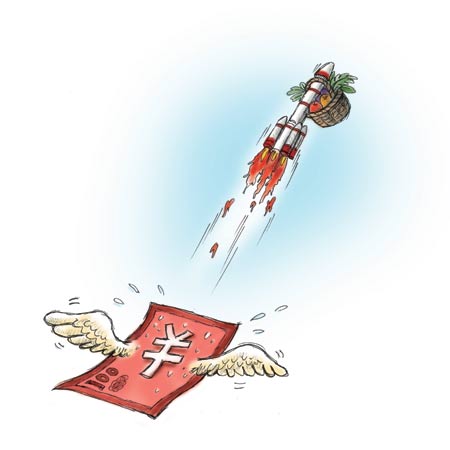Three decades of change affects more than vegetables

Illustration: Liu Rui
I am somewhat surprised by Chen Mingyuan's conclusions. By basing the whole argument on some unproved assumptions and direct observation of annual CPI variations, his analysis lacks careful considerations.
For one thing, anyone who lived through the last three decades in China can't be convinced by the argument that personal incomes have merely increased by 2.4 times over the past 32 years. Looking at food prices or the cost of bus rides is one thing, but we have to take into account the price decreases in a wide range of other consumer products, such as electronics and cars.
As I recall, a mobile phone cost 40,000 yuan ($6,300) in the 1990s and the products were not even usually available. A phone that costs 2,000 yuan ($314) today is far better than the mobile phones back then. It cost a family 2,800 yuan to have a phone installed in Shenzhen when telephones first became popular, but today you're more likely to get it installed for free, along with a package deal for free minutes. Many essentials in the average Chinese household have become far cheaper.
The CPI is not a valid index to reflect the overall changes in the price of consumer products. Though the CPI includes various consumer products, such as groceries, clothes, communication, transportation, health care, and household maintenance, the majority of products sold internationally are not included in CPI calculations.
It is hard to imagine an average Chinese household that could only sustain itself on the products included on the list of items used for the CPI calculation. It also doesn't make sense to compare the CPI of 1978, when the range of items available was far narrower than that of today.
In 1978, when the Chinese economy was highly reliant on central planning, the CPI could hardly reflect the real trends in the market. Although in theory, the "reform and opening-up" policy was initiated in 1978, rationing for food was in place until 1993, and it wasn't until 2000 that the price of newspapers became subject to changes in the free market.
Many consumer products were subsidized or their price and circulation was centrally controlled. Although it seems that you could get considerably more for your yuan back then, we shouldn't forget the constraints of rationing or that, for instance, you could neither purchase nor rent houses for yourself, but had to go through the official system.
Purchasing habits and consumption patterns have changed quite a bit. How often was an average Chinese family able to have meat on the table in 1978? It was easy back then to get cheap, if not free housing, thanks to the centrally controlled property market. Nowadays, though many complain, young professionals with full time jobs can still rent a decent apartment.
It took quite some time for China to reach the market economy. So if we are using prices as a direct measure of comparison, we need to make the necessary adjustments in order to take into account into all the factors associated with central planning.
It also reminds me of some historians' attempts to compare income levels or national GDP between the Qing Dynasty (1644-1911) and the Tang Dynasty (618-908), all of which strike me as purely absurd. So do attempts to compare prices across three decades of massive socio-economic change. Such comparisons are futile, and the results mean little. Although the intention of this analysis is good, flawed analysis is still misleading, and even harmful if cited without caution.
The author is director of the Advanced Research Institute of All-Win Economics. opinion@globaltimes.com.cn
CPI figures don't match realities of today's prices